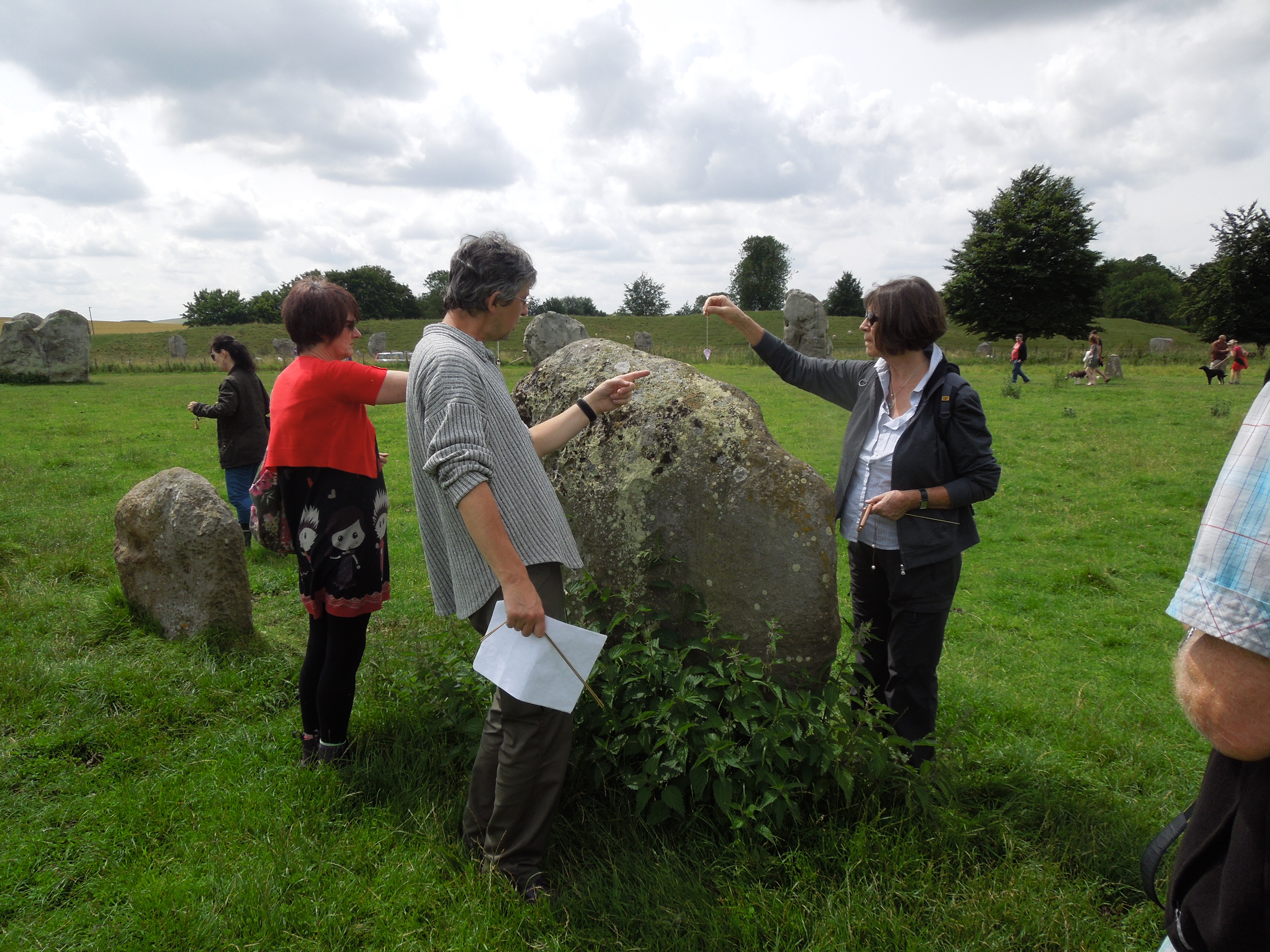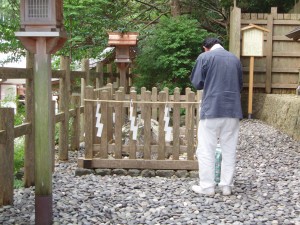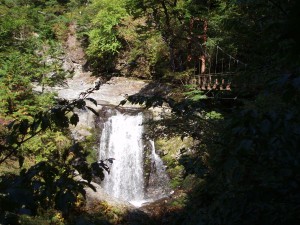
The queue to pray at Tokyo Daijingu, a noted ‘power spot’
The following piece draws on an academic article by Caleb Carter in Japanese Journal of Religious Studies Vol 45, no. 1, p.145-73
**************
In recent years the boom in power spots has seen an increase in visitors to shrines, motivated by connecting with energy sources and entering portals into other worlds. One might think the authorities would welcome this, and many individual priests do, but official Shinto is far from pleased. The organ of the Association of Shrines, called Jinja Shinpo, had this to say (Aug 18, 2004):
Shrines are preserved for the devotion of kami and those who worship them. These long-worshipped sites are now thought to be power spots by some. However, when we recognise the term ‘supotto’ implies a single point, then the timeless history and traditions that have been passed down to us are ignored. Instead, only certain objects within the shrine receive attention. Take the example of a sacred tree reconceived as a power spot: because this spot is conceived as ‘the point’, all other areas of the shrine become neglected. As a result strange behaviours like stroking and hugging sacred trees have become rampant… Feverishly laying their palms on the trees to ‘receive energy’, these visitors fail to appreciate the solemn atmosphere of the shrine premises and forget to pray before the kami. Captivated only by the word ‘power spot’, they truly mistake the original essence of the shrine.

Avebury stone circle in England exudes a special kind of energy
Power spot evolution
But where did the idea of power spots come from? The roots lie in the seminal The Old Straight Track (1925) by Englishman Alfred Watkins. This promoted the idea of leylines, or currents of energy flowing through the ground. Underlying the notion was a belief that the earth was a living organism. Modern science did not recognise the phenomenon because it could only handle physical matter.
By the 1960s certain places were championed for their ‘special vibes’ – Glastonbury in England; Sedona and Mt Shasta in America. Then in 1972 John Michell brought out The View over Atlantis, which drew on geomancy, astro-archaeology, feng shui, pyramidology, numerology and other ancient traditions to claim that there were energy centers all around the world. When the Harmonic Convergence took place in 1987 in celebration of the idea, Mt Fuji was included as one of them.
It was around this time that the first indications of New Age thinking in Japan became evident, introduced by a Shinto priest., head of the Daibenzaiten Shrine in Tenkawa, who published a book called Tenkawa: Super Psychic Spot (1986). Since then Tenkawa has become something of a gathering spot for New Agers, popular with spiritualists, experimental dance groups, UFO seekers and counter-culture artists.
The Tenkawa book was followed by a spate of spiritualists on popular tv programmes being interviewed about their powers, and asked to tell fortunes or identify places with special power. One such person was Kiyota Masuaki, who drew on the Gaia thesis, ley lines, channeling and the Age of Aquarius to produce Hakken! Pawasuppoto (Disovered! Power Spots) (1991.) It took a comprehensive view of the phenomenon, including nature spots as well as temples and shrines.

Praying to a sacred rock at Tenkawa Jinja
The rising popularity of power spots can be seen as part of the spiritual reaction amongst young Japanese against the barren materialistm of the economic drive from the 1970s onwards. The relentless focus on consumerism led on the one hand to new religions and cults like Aum Shinri Kyo, on the other to nature bonding programmes such as the healing power of woods and a fad for weekend riceplanting.
Another influential figure was Ehara Hiroyuki, a television celebrity who was noted for having special ‘power spot’ abilities. His Spiritual Sanctuary series (2005-7) was basically simple tourist-style guides to ‘power shrines’ with their attractions, specialities and souvenirs. They became an enormous success, particularly among young females. Ehara was originally a Shinto priest, and it was he above all who cemented the association of ‘power spots’ with particular shrines.
Neo-nationalism
Following Ehara’s popularity, the power-spot phenomenon was picked up by proponents of neo-nationalist Koshinto. This claims that the Japanese of ancient times had a special relationship with nature, which people of other countries cannot fully appreciate. Ludicrous as this sounds, the idea had gained ground following the election of Shinzo Abe to power. In this way the notion of ‘power spots’, which ironically had originated in England, became increasingly tied into nihonjinron theories about the uniqueness of the Japanese. Power spots were even said to be special to Japan, or specially numerous, because it was ‘kami no kuni’ (the land of the kami).
Ehara’s influence remains evident in the young people at shrines who hold out their hands upturned in front of a rock or waterfall to feel the energy. Similarly, they can be seen sometimes touching or hugging trees. At Kurama, just north of Kyoto, people queue to stand and pray on a ‘power spot’ in front of the temple. Such ideas have been fostered by numerous anime and manga, in which shrines provide a spiritual haven and energy boost.

Tenkawa (Heavenly River) flows past the Daibenzaiten Shrine and emits an energy of its own
Direct engagement with otherworldly power undermines the authority of the priest, which is why shrines are ambivalent about the newfound popularity. While welcoming the attention and increase in visitors, they are concerned about the disregard for hierarchical authority. Just as shamans in ancient times threatened the primacy of the state, so modern ‘power spot seekers’ have opened up direct and democratic ways of tapping into the divine.
Another important lesson to come out of the power spot phenomenon is the mistaken description of Shinto as nature worship. This is such a common idea in the West that it is regularly trotted out as a definition. It is not so much a nature religion, however, as a religion of kami worship. It is why you’ll find shrines located on the top of buildings or in places where not a spot of nature is to be seen. It ignores too the whole ancestral deity aspect of Shinto.
Personally as a child of the 1960s, a hugger of standing stones, I’m partial to the idea of power spots and to the whole idea that different places give off different types of energy. As D.H. Lawrence put it, ‘Different places on the face of the earth have different vital effluence, different vibration, different chemical exhalation, different polarity with different stars: call it what you like. But the spirit of place is a great reality.’
In the end, then, this curious phenomenon is even more intriguing than it seems, for it raises the crucial problem of who has power over the ‘power spot’? It’s a question that in these troubled times is of increasingly vital interest: power to the people, or power to institutional authority?
Like John Lennon, Green Shinto has little doubt where its allegiance lies…
************
For previous postings about power spots, please click the righthand category.

Kyoto power spot, Shimogawa Jinja sacred grove, at the junction of two rivers, the Kamo and the Takano
*****************
For previous postings about power spots, see the category on the righthand side of this page.

Nice article, interesting read!